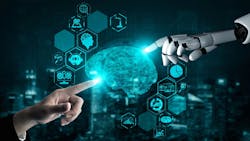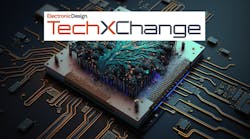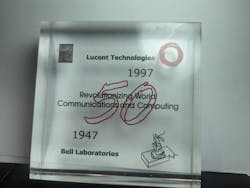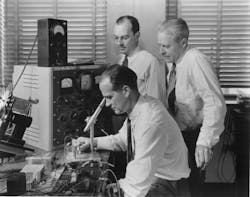"It's Almost as if Silicon Was Waiting for Us": Speculations on AI, Co-Evolution, and the Future of Our Species
What you’ll learn:
- The success of the transistor required many brilliant insights, years of hard work, and a surprising amount of luck.
- Some of that luck involved the decision to use silicon as the basis for most transistor development.
- A look back at a long-ago conversation with two of the transistor era's most prominent pioneers reveals that decision may have had a profound effect on the future of humanity.
It's tough to say whether the rapid adoption of ChatGPT and other AI technologies are heralding an exciting new era for humankind or the beginning of a “kinder, gentler robot apocalypse.” I'm still on the fence about which future we’re facing, but my speculations continue to be shaped by a conversation I had a quarter century ago with two people who inadvertently helped bring us to this point in human history.
It all began back in 1997, during my first tour of duty as an editor with Electronic Design, when I was unexpectedly invited to Bell Labs headquarters in Murray Hill, N.J., to celebrate the 50th anniversary of the invention of the transistor.
The festivities began with a program where the Labs' current staff was treated to a talk given by many of the now-retired Bell researchers who had been involved in the development of the transistor. Each one spent a few minutes recalling their part in the years-long project. The program concluded with a special award presented to the woman who had heroically served as the secretary to Dr. William Shockley, the transistor's notoriously cantankerous co-inventor, followed by lunch, and one of the most remarkable conversations of my life.
Up Close with Kilby and Moore
I'd just tucked into dessert when Dick Muldoon, the Labs' director of communications, dropped by to invite me to a meeting which I assumed would be a routine briefing with some corporate bigwigs. You can imagine my surprise when, a few moments later, I found myself at a table with one other journalist, shaking hands with Jack Kilby, one of the pioneers of the integrated circuit, and Gordon Moore (yes, that Gordon Moore). Caught completely by surprise, I exchanged pleasantries while I struggled to come up with something even remotely intelligent to ask these two legendary individuals.
Following what felt like an uncomfortably long pause, I managed to come up with a single question, one that had been kicking around in my mind during my drive up to the Labs that morning: “How much of the creation of the transistor was based on a skillful extrapolation of what we knew at the time, and how much of its success was the result of unanticipated developments and a healthy dose of good luck?”
I can't remember who spoke first, but I do remember the quiet smiles they exchanged before telling me that, while they did have a good idea of what they were looking for, there had also been a surprising amount of luck involved. According to Mr. Moore, that luck came in the form of four fateful decisions, three of which I'll talk about at some other time.
While all four choices played important roles in how the transistor changed the history of humanity, the decision to focus on silicon as the primary material for making them may have been the most impactful of the four—and certainly the most mysterious.
The original transistor was an "ungainly assemblage of germanium, plastic, and gold, topped off by a squiggly spring.” However, most researchers soon began devoting most of their efforts to using silicon to make bipolar and, eventually, field-effect-type transistors.
Silicon: The Material of Choice
Kilby and Moore agreed that several other candidate materials seemed equally promising, but, in retrospect, silicon possessed several unique characteristics that they weren’t aware of at the time. Among the most significant of these were silicon's chemical properties, which made it amenable to relatively straightforward photolithographic manufacturing processes that enabled the development of monolithic integrated circuits by Kilby, Noyce, and other pioneers a decade later.
Mr. Kilby chimed in, saying that that the invention of the transistor was pretty much inevitable, but the explosive growth made possible by silicon was not. "It was almost as if silicon was waiting for us," added Moore, noting that even he was initially surprised at its ability to support the steadily increasing circuit densities that enabled him to make his fortune with Intel.
Driving home that day, I found myself fascinated by Moore's casual comment, wondering if, somehow, silicon had indeed been some sort of genie, waiting for us to unleash it from its bottle?
Fiction vs. Reality
In an absurd thought experiment, I imagined that silicon was some sort of elemental virus, and that we had somehow become its unwitting hosts. If that were the case, the notion that it was tricking us into to helping it reproduce while creating ever-more complex versions of itself didn't seem completely out of the question. From that perspective, one could almost imagine that silicon was using humanity's economic system to build the machinery it would need to evolve into its own form of conscious entity.
Two and a half decades ago, when only a few aspects of those surreal imaginings seemed to mirror real-life events uncomfortably well, I was mostly able to dismiss them as products of my overactive imagination, or maybe an interesting plot for a science fiction novel. Lately, however, as a rapidly growing percentage of businesses that form the global economy have begun to rely on powerful AI technologies to accelerate their own growth, I'm having a harder time distinguishing reality from fiction.
While there’s no way that silicon is a life-form in the formal sense, it almost appears as if we may have somehow imprinted it with some of the same cleverness that’s allowed us to become the dominant species on our home planet. So, it's not inconceivable we have somehow created an "exo-virus" that’s using us, and the technologies we've developed, as a host to foster its own evolution.
While this remains an unsubstantiated and highly unlikely possibility, Gordon Moore's casual comment continues to haunt me. I wonder about how our relationship to silicon, and the AI it makes possible, will evolve over the next few years. Will their virus-like properties cause them to mimic the behavior of something like Ebola, which burns through its host as it propagates to its next victim, or will we manage to establish some sort of benign co-evolutionary relationship with our creation?
Our bodies already serve as host to many other organisms that benefit us, including the mitochondria in our cells which now serve as an integral part of our biology. So, I'm hoping we can learn to do the same with silicon. I'm not sure if my far-fetched theory has any basis in truth. But if true, I believe that much of how the relationship between humans and the exo-life we may have created will be determined by the choices we make in the next few years.
Let’s all work hard to make wise choices.
What are your thoughts on our relationship with technology? Please share them in the comments below, or write me at lgoldberg(at)green-electronics.com.
Read more articles in the TechXchange: Generating AI.
About the Author
Lee Goldberg
Contributing Editor
Lee Goldberg is a self-identified “Recovering Engineer,” Maker/Hacker, Green-Tech Maven, Aviator, Gadfly, and Geek Dad. He spent the first 18 years of his career helping design microprocessors, embedded systems, renewable energy applications, and the occasional interplanetary spacecraft. After trading his ‘scope and soldering iron for a keyboard and a second career as a tech journalist, he’s spent the next two decades at several print and online engineering publications.
Lee’s current focus is power electronics, especially the technologies involved with energy efficiency, energy management, and renewable energy. This dovetails with his coverage of sustainable technologies and various environmental and social issues within the engineering community that he began in 1996. Lee also covers 3D printers, open-source hardware, and other Maker/Hacker technologies.
Lee holds a BSEE in Electrical Engineering from Thomas Edison College, and participated in a colloquium on technology, society, and the environment at Goddard College’s Institute for Social Ecology. His book, “Green Electronics/Green Bottom Line - A Commonsense Guide To Environmentally Responsible Engineering and Management,” was published by Newnes Press.
Lee, his wife Catherine, and his daughter Anwyn currently reside in the outskirts of Princeton N.J., where they masquerade as a typical suburban family.
Lee also writes the regular PowerBites series.




